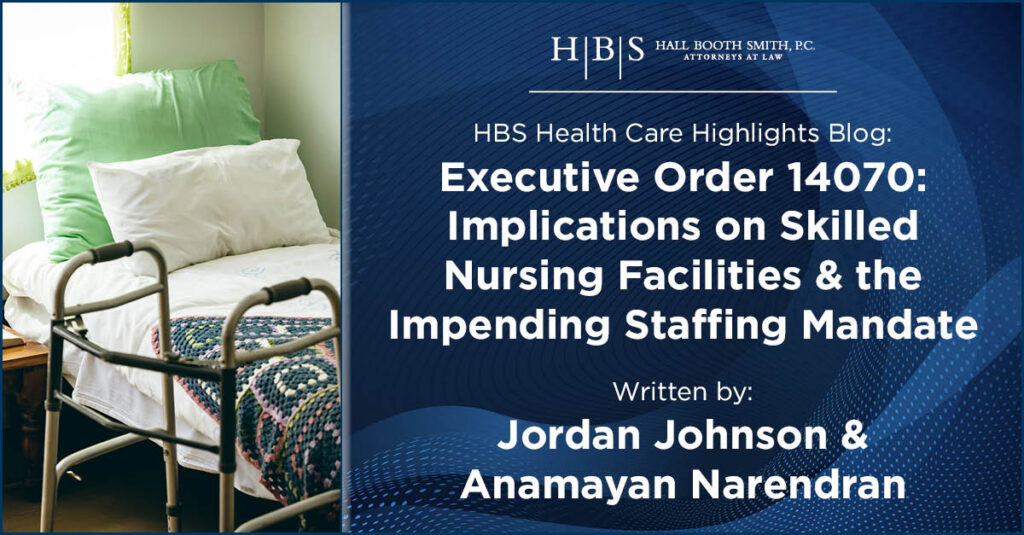
Executive Order 14070: Implications on Skilled Nursing Facilities & the Impending Staffing Mandate

Written by: Jordan Johnson, Esq. & Anamayan Narendran, Esq.
Background
On April 18, 2023, President Biden signed Executive Order 14070 that included several directives purportedly aimed at bolstering Americans’ access to long-term care and increasing job stability for medical professionals working in long-term care facilities.
The Executive Order directs the Department of Health and Human Services (DHHS) to contemplate issuing various regulations to fortify long-term care jobs by expanding on minimum staffing requirements and mitigating staffing turnover for these facilities, using Medicare and Medicaid funding as an incentive.
Key Points
Despite Section 2(a)(i) of the Executive Order’s stated purpose “[t]o increase compensation and benefits for . . . long-term care professionals who are providing federally funded services” (emphasis added), the instruction to the Centers for Medicare and Medicaid Services (CMS) for guidance to States on ways to use enhanced funding only includes home and community-based services who provide services to Medicaid beneficiaries, not skilled nursing facilities.
Section 2(b) goes onto provide that “[t]o improve working conditions and job quality in . . . long term care programs, encourage providers to establish incentives to recruit and retain workers, help prevent burnout, … the Secretary of Health and Human Services shall . . . [implement] rulemaking on nursing home staffing transparency to promote adequate staffing at nursing homes, building on the [DHHS’s] efforts to propose minimum standards for staffing adequacy at nursing homes.” This directive likely seeks to establish a transparency requirement that is tied to increased staffing ratios that are then published to the public.
The Executive Order further provides that the Secretary of Health and Human Services shall “consider additional actions to reduce nursing staff turnover in nursing facilities and improve retention of those staff, advancing the [DHHS]’s efforts to measure and adjust payments based on staff turnover.” In other words, this directive refers to reducing Medicare payments to nursing homes based on the specific staffing turnover metrics of each facility.
Accordingly, major nursing home associations, including American Health Care Association (AHCA) and LeadingAge have expressed concerns with the directives set forth in Executive Order 14070 including the likely reduced funding for facilities with greater staff turnover, with less, or no financial assistance including increased Medicare or Medicaid rates to help retain such staff through greater compensation or other benefits.
Potential Consequences
The implications of the directives contained in Executive Order 14070, or any minimum staffing requirement imposed by CMS, could have a lasting impact on millions of Americans that rely on long-term care facilities for their daily needs. The Executive Order seeks to compel long-term care providers to develop and maintain staffing metrics with the intent to ensure each facility meets a staffing threshold to continue operating.
However, implementing correctional policies by penalizing a market that already finds itself in constant turnover could, in turn, worsen the ongoing crisis. As the AHCA and National Center for Assisted Living, which represent over 14,000 nursing homes and other long term care facilities across the country that provide care to approximately five million people each year, released the following statement in reaction to Executive Order 14070:
“We appreciate the Biden Administration’s focus on improving quality of care for our nation’s seniors and supporting long term care workers, as our sector continues to face a historic workforce crisis. We are supportive of incentivizing providers to improve on key quality metrics, including staff turnover. At the same time, we need policymakers to offer programs and solutions that will help us attract and retain caregivers to ensure residents are well supported. Turnover metrics are important, but we need significant, meaningful aid to help address the root causes of turnover and offer more competitive, good-paying jobs. We look forward to working with the Biden Administration on how we can improve the entire long term care continuum.”
This concern mirrors that of the impending minimum staffing requirements.
President Biden first announced implementing minimum staffing requirements for long-term care facilities in February of 2022. On April 4, 2023, CMS proposed a 3.7% net compensation increase, or approximately $1.2 billion, in Medicare Part A payments, to skilled nursing facilities in 2024, but did not condition a staffing requirement upon such proposal. Nevertheless, CMS pledged that it remained committed to implementing a minimum staffing requirement “later this spring.” To date, no such minimum exists.
Long-term care providers have pushed back on a federal staffing mandate that would not be funded with the resources necessary to meet specific staffing requirements given the labor shortage in front line workers seeking employment in long-term care facilities. Likewise, there has been a push back on the manner in which a mandate of this nature would impact long-term care providers in certain geographical areas with more limited workforces.
Conclusions
The reality remains that record amounts of long-term care facilities were forced to close as a result of the COVID-19 pandemic and its impact on retention of front-line workers. Facilities that remain open are still remedying the current pace of modest job growth and are yet to return to pre-pandemic staffing levels in 2023.
Be that as it may, leveraging Medicare payments as a method to implement staffing controls may in turn hinder the ability of long-term care facilities to continue its trajectory toward pre-pandemic staffing numbers and potentially result in the closure of facilities that so many American families rely upon for the care of themselves or their loved ones. Without any further link between Medicare payments and nursing hours, wages, benefits, and resources, these long-term care facilities with staffing turnover problems will merely perpetuate an ongoing predicament until the inevitable closure of several of these facilities.
Until such a comprehensive plan is developed, and implemented, long-term care facilities face an unrealistic and unattainable expectation of meeting certain staffing minimums with the risk of having Medicare payments withheld.
If you have any questions regarding Executive Order 14070 or the impending staffing mandate, please contact a member of our Aging Services team.
Disclaimer
This material is provided for informational purposes only. It is not intended to constitute legal advice nor does it create a client-lawyer relationship between Hall Booth Smith, P.C. and any recipient. Recipients should consult with counsel before taking any actions based on the information contained within this material. This material may be considered attorney advertising in some jurisdictions. Prior results do not guarantee a similar outcome.


Leave a comment
You must be logged in to post a comment.